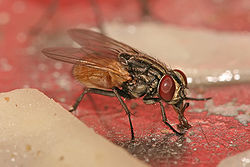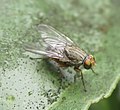This article includes a list of general references, but it lacks sufficient corresponding inline citations. (September 2013) |
| Muscidae | |
|---|---|

| |
| Musca domestica | |
| Scientific classification | |
| Kingdom: | Animalia |
| Phylum: | Arthropoda |
| Class: | Insecta |
| Order: | Diptera |
| Clade: | Eremoneura |
| (unranked): | Cyclorrhapha |
| Section: | Schizophora |
| Subsection: | Calyptratae |
| Superfamily: | Muscoidea |
| Family: | Muscidae Latreille, 1802 |
| Subfamilies | |
Muscidae are a family of flies found in the superfamily Muscoidea.
Muscidae, some of which are commonly known as house flies or stable flies due to their synanthropy, are worldwide in distribution and contain almost 4,000 described species in over 100 genera.
Most species are not synanthropic. Adults can be predatory, hematophagous, saprophagous, or feed on a number of types of plant and animal exudates. They can be attracted to various substances including sugar, sweat, tears [1] and blood. Larvae occur in various habitats including decaying vegetation, dry and wet soil, nests of insects and birds, fresh water, and carrion.
The housefly, Musca domestica, is the best known and most important species.
Some, from the genera Hydrotaea and Muscina, are involved in forensic case studies.
Identifying characteristics
[edit]The antennae are three-segmented and aristate; vein Rs is two-branched, a frontal suture is present, and the calypters are well developed. The arista is often plumose for the entire length. The hypopleuron is usually without bristles; generally, more than one sternopleural bristle is present. The R5 cell is either parallel-sided or narrowed distally. Vein 2A is short and does not reach the wing margin.
The Fanniidae, which used to be a subfamily (Fanniinae) of the Muscidae, share these characters, but may be separated from them by the absence of the identifying characteristics for the family Fanniidae.
Biology
[edit]Larvae mainly develop in decaying plant material or manure.
Health and economic importance
[edit]Adults of many species are passive vectors of pathogens for diseases such as typhoid fever, dysentery, anthrax, and African sleeping sickness.
Larvae of some Atherigona species are important pests in cultivation of cereals, like rice and maize.
Evolution
[edit]Seven species in six described genera have been recorded from the fossil record. Lambrecht (1980: 369) estimated that the family Muscidae originated as long ago as the Permian, although no fossil record exists for the family any older than the Eocene.
Genera
[edit]List of genera according to the Catalogue of Life:[1]
- Adia
- Aethiopomyia
- Afromydaea
- Agenamyia
- Albertinella
- Alluaudinella
- Altimyia
- Amicitia
- Anaphalantus
- Andersonosia
- Anthocoenosia
- Apsil
- Arthurella
- Atelia
- Atherigona
- Auria
- Azelia
- Balioglutum
- Beccimyia
- Biopyrellia
- Bithoracochaeta
- Brachygasterina
- Brevicosta
- Bruceomyia
- Bryantina
- Buccophaonia
- Calliphoroides
- Camptotarsopoda
- Caricea
- Cariocamyia
- Cephalispa
- Chaetagenia
- Chaetopapuaia
- Chaetophaonia
- Charadrella
- Chortinus
- Coenosia
- Cordilura
- Cordiluroides
- Correntosia
- Crucianella
- Curranosia
- Cypselodopteryx
- Cyrtoneurina
- Dasyphora
- Deltotus
- Dichaetomyia
- Dimorphia
- Dolichophaonia
- Drepanocnemis
- Drymeia
- Eginia
- Eginiella
- Eudasyphora
- Exsul
- Fraserella
- Graphomya
- Gymnodia
- Gymnopapuaia
- Haematobia
- Haematobosca
- Haematostoma
- Haroldopsis
- Hebecnema
- Helina
- Helinomydaea
- Heliographa
- Hemichlora
- Hennigiola
- Hennigmyia
- Huckettomyia
- Hydrotaea
- Idiohelina
- Insulamyia
- Itatingamyia
- Lasiopelta
- Limnohelina
- Limnophora
- Limnospila
- Lispacoenosia
- Lispe
- Lispocephala
- Lispoides
- Lophosceles
- Macroeginia
- Macrorchis
- Magma
- Megophyra
- Mesembrina
- Metopomyia
- Microcalyptra
- Mitroplatia
- Morellia
- Mulfordia
- Musca
- Muscina
- Mydaea
- Myiophaea
- Myospila
- Neivamyia
- Neodexiopsis
- Neohelina
- Neolimnophora
- Neomuscina
- Neomyia
- Neorypellia
- Neurotrixa
- Notoschoenomyza
- Nystomyia
- Ochromusca
- Ocypodomyia
- Ophyra
- Opsolasia
- Orchisia
- Oxytonocera
- Pachyceramyia
- Palpibracus
- Papuaia
- Papuaiella
- Paracoenosia
- Paralimnophora
- Parastomoxys
- Parvisquama
- Passeromyia
- Pectiniseta
- Pentacricia
- Phaomusca
- Phaonia
- Phaonidia
- Phaonina
- Philornis
- Pictia
- Pilispina
- Plexiopsis
- Plumispina
- Polietes
- Polietina
- Potamia
- Prohardyia
- Prostomoxys
- Pseudocoenosia
- Pseudohelina
- Pseudoptilolepis
- Psilochaeta
- Pygophora
- Pyrellia
- Pyrellina
- Reinwardtia
- Reynoldsia
- Rhabdoptera
- Rhinomusca
- Rhynchomydaea
- Rypellia
- Sarcopromusca
- Scenetes
- Schoenomyza
- Schoenomyzina
- Scutellomusca
- Sinophaonia
- Souzalopesmyia
- Spanochaeta
- Spathipheromyia
- Spilogona
- Stomopogon
- Stomoxys
- Stygeromyia
- Syllimnophora
- Syngamoptera
- Synthesiomyia
- Tamilomyia
- Tertiuseginia
- Tetramerinx
- Thaumasiochaeta
- Thricops
- Trichomorellia
- Villeneuvia
- Xenomorellia
- Xenomyia
- Xenotachina
- Xestomyia
Types
[edit]Images
[edit]-
Mydaeinae sp.
-
Stable fly, Stomoxys calcitrans, Albuquerque
-
Muscidae sp.
-
Limnophora sp.
Further reading
[edit]- Identification
- Hennig, W. (1955–64). Muscidae in Erwin Lindner, Die Fliegen der Paläarktischen Region 63b,Schweizerbart,Stuttgart.
- Huckett, H.C. 1965. The Muscidae of northern Canada, Alaska and Greenland (Diptera). Memoirs of the Entomological Society of Canada 42: 1–369. 23 plates of drawings.
- Séguy, E., 1937, Diptera, family Muscidae. In: P. Wystmann (ed.), Genera Insectorum, Brussels, 205: 604. Includes a key to world genera.
- Shinonaga, S. & Kano, R., 1971, Fauna Japonica Muscidae (Insecta:Diptera), Academia press,242pp.+28Plates. Keys to Eastern Palaearctic genera of several subfamilies.
- Gregor, Fr. et al., 2002 The Muscidae (Diptera) of Central Europe, Brno, Folia Biologia, 107.
- Biology
- Use of DNA in forensic entomology
- Skidmore, P., 1985, The biology of the Muscidae of the world. Junk, Dordrecht. Series entomologica, 29, xiv + 550p.
Links to Genera and species lists
[edit]References
[edit]- ^ Bisby F.A., Roskov Y.R., Orrell T.M., Nicolson D., Paglinawan L.E., Bailly N., Kirk P.M., Bourgoin T., Baillargeon G., Ouvrard D. (red.) (2011). "Species 2000 & ITIS Catalogue of Life: 2011 Annual Checklist". Species 2000: Reading, UK. Retrieved 24 September 2012.
{{cite web}}: CS1 maint: multiple names: authors list (link) - ^ Pont, Adrian C.; Werner, Doreen (2006). "The Types of Fanniidae and Muscidae (Diptera) in the Museum für Naturkunde, Humboldt-Universität zu Berlin, Germany". Mitteilungen aus dem Museum für Naturkunde in Berlin – Zoologische Reihe. 82: 3–139. doi:10.1002/mmnz.200600001.






